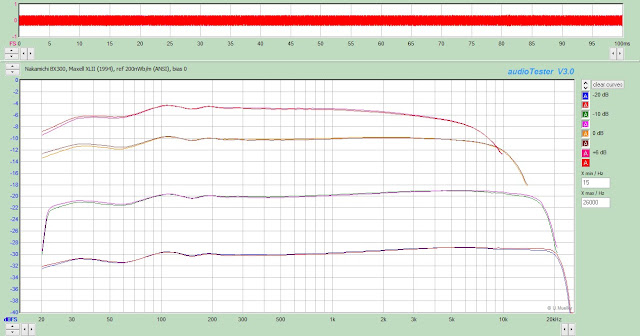Introduction
This continues my evaluation of old cassette tapes, this time a bunch of TDK entry-level ferrics.
The details of the test methods are here.
Maxell UR C90 (1994) (what the deck was calibrated for)
Relative bias: (reference)Relative sensitivity: (reference)
THD @ Dolby level: 0.42%
MOL400(THD=1%): +3.4dB
MOL400(THD=3%): +5.3dB
MOL1k(THD=3%): +2.9dB
SOL10k: -1.3dB
SOL15k: -7.3dB
Bias noise: -49.5dB, -52.5dB(A)
Dynamic range: 57.8dB
TDK D (1979)
Relative bias: -2
Relative sensitivity: -0.6dB
THD @ Dolby level: 1.4%
MOL400(3%): +1.9dB
SOL10k: -3.2dB
Bias noise: -48.4dB, -51.5dB(A)
Dynamic range: 53.4dB
Old it may be, but this D was in a great shape. The tape, a very
pale brown, looked pristine. Its performance is not bad at all, with a
bit less noise than early Maxell UL.
Later addition: I have by now tested ten of these cassettes, including their Kenwood N siblings. All of them performed flawlessly, after 40+ years.
TDK D (1982)
Relative bias: -2Relative sensitivity: -0.5dB
THD @ Dolby level: 1.2%
MOL400(3%): +2.7dB
SOL10k: -2.6dB
Bias noise: -48.2dB, -51.1dB(A)
Dynamic range: 53.8dB
An evolution of the previous one. The same pale colour, MOL and SOL have increased a little bit, but noise too.
TDK D (1986)
Relative bias: 0Relative sensitivity: -0.9dB
THD @ Dolby level: 0.7%
MOL400(3%): +3.7dB
SOL10k: -1.5dB
Bias noise: -49.5dB, -53.0dB(A)
Dynamic range: 56.7dB
An entirely different tape, with much better MOL, SOL, and noise.
TDK D (1988)
Relative bias: -2.5Relative sensitivity: 0dB
THD @ Dolby level: 0.9%
MOL400(1%): +0.4dB
MOL400(3%): +3.5dB
MOL1k(3%): +2.3dB
SOL10k: -1.5dB
Bias noise: -49.6dB, -52.8dB(A)
Dynamic range: 56.3dB
TDK D (1990)
Relative bias: +1Relative sensitivity: 0dB
THD @ Dolby level: 0.40%
MOL400(3%): +3.4dB
MOL400(3%): +6.0dB
MOL1k(3%): +5.1dB
SOL10k: -1.4dB
Bias noise: -48.7dB, -51.8dB(A)
Dynamic range: 57.8dB
TDK D (1992)
Relative bias: +2Relative sensitivity: +0.3dB
THD @ Dolby level: 0.40%
MOL400(3%): +4.4dB
MOL400(3%): +7.0dB
MOL1k(3%): +3.7dB
SOL10k: -0.3dB
Bias noise: -48.4dB, -51.8dB(A)
Dynamic range: 58.8dB
TDK D (1995)
Relative bias: +5Relative sensitivity: -0.1dB
THD @ Dolby level: 0.40%
MOL400(3%): +3.5dB
MOL400(3%): +6.0dB
MOL1k(3%): +3.4dB
SOL10k: -0.5dB
Bias noise: -49.0dB, -52.4dB(A)
Dynamic range: 58.4dB
TDK D (1998)
Relative bias: -1.5Relative sensitivity: +1.0dB
THD @ Dolby level: 0.66%
MOL400(1%): +5.0dB
MOL400(3%): +6.8dB
MOL1k(3%): +2.6dB
SOL10k: -1.2dB
Bias noise: -49.5dB, -52.5dB(A)
Dynamic range: 59.3dB
My first sample of this tape, which may have been NOS, was troublesome, with a large channel imbalance and a rather unstable level. Then in June 2020 I found another one, in much better shape. The performance parameters of the two were the same, but the second sample was 0.9dB more sensitive. MOL is outrageous, so that its dynamic range ends up almost on a par with past TDK super ferrics. Another curiosity is that distortion remains below 1% up until very high levels. This is, electro-magnetically at least, a fantastic budget tape.
TDK A (1986)
Relative bias: +2
Relative sensitivity: -0.2dB
THD @ Dolby level: 0.40%
MOL400(1%): +4.0dB
MOL400(3%): +6.2dB
MOL1k(3%): +5.0dB
SOL10k: -1.0dB
Bias noise: -48.2dB, -51.5dB(A)
Dynamic range: 57.7dB
TDK's budget tape, slotted in below D. Curiously this is unlike any D, and in some respects better than its contemporaries.
TDK FE (1995)
Relative bias: +0.5Relative sensitivity: +0.4dB
THD @ Dolby level: 0.47%
MOL400(1%): +4.9dB
MOL400(3%): +6.8dB
MOL1k(3%): +2.8dB
SOL10k: -0.8dB
Bias noise: -49.1dB, -52.3dB(A)
Dynamic range: 59.1dB
A more modern budget tape. Again unlike D, and very competent. This sample was manufactured in 1997.
TDK FE (1997)
Relative bias: +1Relative sensitivity: +0.5dB
THD @ Dolby level: 0.30%
MOL400(1%): +4.5dB
MOL400(3%): +6.5dB
MOL1k(3%): +4.0dB
SOL10k: -0.5dB
Bias noise: -49.1dB, -52.3dB(A)
Dynamic range: 58.8dB
This sample was manufactured in 2002. The tape may well be the same as in the 1995 version. Outwardly boxes, cards, and shells appear to be identical, but the younger one lacks a hum shield.
TDK FE (2008)
Relative bias: 0Relative sensitivity: -0.4dB
THD @ Dolby level: 0.38%
MOL400(1%): +2.8dB
MOL400(3%): +5.0dB
MOL1k(3%): +3.1dB
SOL10k: -1.0dB
Bias noise: -47.5dB, -50.6dB(A)
Dynamic range: 55.6dB
An FE from the Imation era. I don't know when this model was launched. The sample is from 2008. The tape differs markedly from the previous version, with lower MOL and much higher noise. Performance is very similar to other last-generation or modern-day ferrics (i.e. UR, Fox, ...)
TDK B fake? (2020?)
Relative bias: -1Relative sensitivity: +0.4dB
THD @ Dolby level: 0.53%
MOL400(1%): +3.1dB
MOL400(3%): +6.0dB
MOL1k(3%): +3.9dB
SOL10k: -1.8dB
Bias noise: -47.4dB, -50.7dB(A)
Dynamic range: 56.7dB
I must admit I don't know for sure what this is. It was sent to me without its wrapper, but with the message that it is a Chinese fake, presumably like what can be found in abundance on AliExpr*ss and AliB*b*. The shell seems to be the same as the Onn cassettes sold by W*lm*rt. That shell runs smoothly, and the magneto-acoustical performance is not bad at all!
There was one fly in the ointment: side A had a somewhat unstable treble, more so in the left channel, and this without any visible damage to the tape. That prompted me to set bias a bit lower. Switching to side B solved this, and that is how the above frequency plots were made. With hindsight leaving bias at 0 might have been better. I later learned that a weak side A left channel is typical for this cassette.
INDEX OF ALL CASSETTES



















































